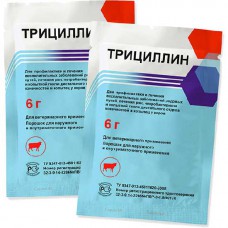Expiration date: 01/2026
DESCRIPTION
Tricillin (Tricyllinum) - powder for the prevention and treatment of inflammatory diseases of the birth canal, treatment of wounds, necrobacteriosis and hoof rot of the distal extremities and hooves in cows. In appearance, the drug is a white powder.
STRUCTURE
Tricillin in 1 g as active ingredients contains: benzylpenicillin sodium salt-70,000 units, streptomycin sulfate-80,000 units, streptocide-0.83 g.
PHARMACOLOGICAL PROPERTIES
Pharmacotherapeutic group: combined antibacterial drugs. Benzylpenicillin sodium salt has a bactericidal effect by inhibiting the synthesis of the cell wall of microorganisms. It has a broad spectrum of antibacterial action against most Gram-positive and some Gram-negative microorganisms, including staphylococci, streptococci and Campylobacter.
Streptomycin sulfate has a bacteriostatic and bactericidal effect against many Gram-positive and Gram-negative pathogens. The antimicrobial activity of streptomycin is associated with inhibition of protein synthesis at the level of ribosomes in the microbial cell.
Streptocide has a bacteriostatic effect against gram-positive and gram-negative pathogenic microbes. It disrupts the formation of growth factors in microorganisms – folic and dehydrofolic acids.
With intrauterine administration, the drug is poorly absorbed and has an antibacterial effect, mainly in the tissues of the uterus. It is excreted from the body mainly by the kidneys in unchanged form and in the form of metabolites in lactating animals-partly with milk. According to the degree of exposure to the body, tricillin is a moderately dangerous substance (hazard class 3 according to GOST 12.1.007).
DOSAGE AND APPLICATION
Tricillin is prescribed to cows for the prevention and treatment of postpartum endometritis and other inflammatory diseases of the birth canal of bacterial etiology, after delivery, caesarean section, surgical separation of the afterbirth, with complicated labor and injuries of the birth canal, as well as for the treatment of wounds and as part of complex therapy in the treatment of necrobacteriosis and hoof rot of the distal extremities and hooves.
Before using the drug for the prevention and treatment of postpartum endometritis, the external genitalia and the root of the tail are sanitized. If necessary, release the uterine cavity from inflammatory exudate. For the prevention and treatment of postpartum endometritis when the afterbirth is delayed: 12-24 hours after calving, Tricillin is injected into the uterine cavity at a dose of 2.5-3 g, as well as under the placenta located in the vagina at a dose of 1.5 g.The drug is diluted in 50-100 ml of sterile vegetable oil at room temperature. The treatment is carried out every 48 hours until the spontaneous separation of the afterbirth, but no more than 3 times.
After surgical separation of the afterbirth: for the prevention of diseases of the birth canal, Tricillin is injected into the uterine cavity twice in a dose of 1.5-3 g at intervals of 48 hours. In complicated labor, injuries of the birth canal after delivery and cesarean section, Tricillin is injected into the uterine cavity once at a dose of 1.5-3 g.
For the treatment of wounds, the drug in an amount of 3-6 g (depending on the size of the affected area) is applied evenly over the entire area of the wound with the capture of adjacent healthy tissues within a radius of 3-5 mm. If repeated use is necessary, the drug is applied at the same dose 48 hours after the first application.
For the treatment of necrobacteriosis and hoof rot of the distal extremities and hooves as part of complex therapy, Tricillin is applied depending on the area of the affected surface and the depth of the lesion in an amount of 2.5-3 g 2-3 times with an interval of 72 hours.
SPECIAL INSTRUCTIONS
Symptoms of overdose when using the drug in accordance with this instruction have not been identified.
The features of the drug's action during its first use and cancellation were not revealed.
You should avoid skipping the next application of the drug, as this can lead to a decrease in therapeutic effectiveness. In case of missing one dose, the use of the drug is resumed in the same dosage and according to the same scheme.
Tricillin is not prescribed simultaneously with other intrauterine medications.
Slaughter of animals for meat is allowed no earlier than 6 days after the last application of Tricillin. The meat of animals that are forced to be killed before the expiration of the specified period can be used as food for fur-bearing animals. Milk obtained during treatment and within 6 days after the last administration of Tricillin is forbidden to be used for food purposes; such milk can be used after boiling in animal feed.
CONTRAINDICATIONS
Contraindication to the use of Tricillin is an increased individual sensitivity of the animal to the components of the drug.
SIDE EFFECTS
When using the drug in accordance with this instruction, side effects and complications are usually not observed. With increased individual sensitivity of the animal to the components of the drug and the appearance of signs of allergy, the use of Tricillin is discontinued and the animal is prescribed antihistamines and symptomatic therapy.
SHELF LIFE AND STORAGE
Store Tricillin in the closed packaging of the manufacturer in a dry place, protected from direct sunlight, separate from food and feed, at a temperature of 5 °C to 20 °C. The shelf life of the medicinal product, subject to storage conditions, is 3 years from the date of production. It is forbidden to use the drug after the expiration date.




